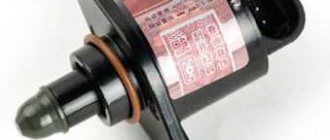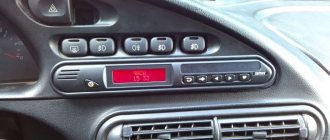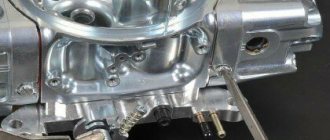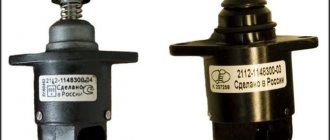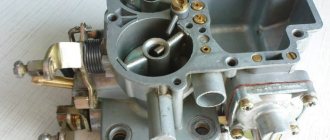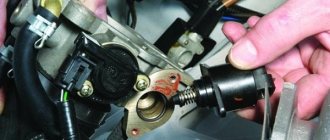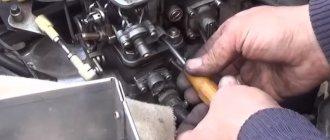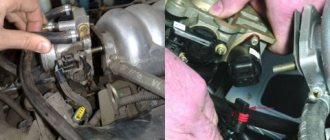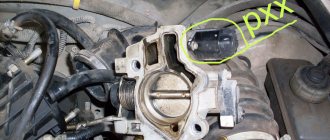Carburetor speed fluctuates
You rarely see imported components on domestic cars.
Basically, AvtoVAZ engines are equipped with a Solex or Ozone carburetor. Less often you can find products from the Dimitrovgrad Aggregate Plant, known for its reliability: the DAAZ carburetor. Drivers of relatively modern cars, accustomed to the check engine light, can easily determine any malfunction using an on-board computer or an inexpensive car scanner, but for veteran engine owners, only hardware diagnostics are available. A common malfunction is idle speed floating, the main symptoms are:
- It would seem that the problem does not affect the speed - with intensive use of the gas pedal, the malfunction is invisible. However, it is dangerous in traffic jams, when the engine may suddenly stall, and when engine braking on a long descent;
- In addition, increased vibrations do not add life to the motor and attachments. Bearings of rotating shafts experience axial loads that are not typical for them. And it is uncomfortable for passengers to be in the car when the tachometer needle jumps from 500 to 1500 rpm.
The driver is forced to constantly apply gas, this distracts from the road and increases gas consumption.
So, manifestations of floating idle:
- The tachometer needle moves smoothly or sharply in the range of 1000 revolutions;
- The car shakes noticeably: there is always a feeling that it will stall;
- Pops of unburned fuel in the muffler and under the hood. In the first case, the mixture is rich, in the second, it is lean;
- Vibrations similar to tripping (at the same time you are sure that the spark plugs and the high-voltage part of the ignition system are in good condition);
- The motor randomly picks up speed, then smoothly reduces it. The problem is non-linear, it suddenly appears and also disappears suddenly (this somewhat complicates the diagnosis).
It is not difficult to localize the fault. If (we repeat: in the absence of other malfunctions), the speed fluctuates, look at the carburetor.
Carburetor diagnostics after adjustment:
Now you need to make sure that all settings are set correctly. To do this, you need to start the engine and watch it idle. Is he starting to trip? Next, press the accelerator sharply and also sharply release it. Can you hear any dips? If yes, the fuel quality adjustment screw needs to be unscrewed a little.
During heavy braking, the engine should continue to operate stably. If it stalls, you need to slightly unscrew the quality screw.
Thus, you now know how to adjust the carburetor on a VAZ 2106 on your own without special tools.
Why the speed fluctuates - localization of the fault
First, you need to cut off potential sources of the problem close to the carburetor.
- Let's leave the fuel supply alone. It (gasoline) is either there and the engine is running, or it is not there and there is no problem with idling (as well as the engine itself);
- A potential culprit is a clogged engine air filter. The main cause of uneven idle is air, or rather oxygen, so we inspect the first obstacle in the way of oxygen especially carefully. If you changed the filter at the end of spring, it may be clogged with June poplar fluff. Regular trips on primers, or clouds of dust donated by the “coaters”, coke the pores of the filter element within a month. It happens that a low-quality product from “homemade” ones from the Middle Kingdom simply breaks into shreds and clogs the carburetor throttle assembly with scraps. In any case, let's start by checking the filter;
- The diametrically opposite reason is excess oxygen. The intake tract of an internal combustion engine is relatively sealed. All incoming air flows are carefully calculated by engineers. In injection systems there is a mass air flow sensor, and the ECU can adjust the mixture parameters depending on the oxygen flow. The carburetor has only a mechanical setting for a certain volume. Any unauthorized air leak causes floating speed. The filter breaks, the valve cover gasket breaks, or the carburetor seal leaks - and unaccounted for (and also dirty) air goes into the chamber. The leak can be on the fittings of the vacuum tubes and on the crankcase ventilation system.
A less common cause is the housing or diaphragm of the distributor vacuum regulator. That is, the device responsible for the stable operation of the power unit is itself the cause of the malfunction.
If none of the listed reasons are found, we will inspect the carburetor. Moreover, no special equipment, much less electronic devices, is required.
Are there any other reasons for the sharp drop in revolutions?
There can be many reasons for such trouble. If you are repairing a car yourself, you should take a slightly broader look at the problem and try to find the causes in other components. But you should move on to other features of the car only if you are convinced of the high quality of the carburetor, normal fuel and other features mentioned above. Here are some more ideas to check out:
- fuel filters – very often filter elements become clogged, and owners forget to change them on time, and this leads to serious problems with the vehicle;
- thermostat - perhaps after a slight warm-up of the small circle, your thermostat opens and releases sharply icy liquid into the engine, which leads to a drop in speed;
- electronics – it’s worth checking the ignition, the normal installation of the timing belt, the absence of problems with sensors and various electronic equipment on board your car;
- turning on electricity consumers - perhaps some powerful device is automatically turned on in your car, which puts a load on the unit, the speed inevitably drops;
- valve system - in this case there will be no sharp drops and drops, but floating and unstable speeds are quite possible, and under load they will turn into drops.
There can be many reasons for engine instability. Sometimes the problem is that the generator at a certain point stops producing normal voltage, which affects the operation of the engine's electrical systems. The engine may also be stressed due to poor oil or internal failures in the cylinder block or valve system. So in this case, you can dig for quite a long time, but it is better to visit a service station and find the cause of the problem.
Methodology for finding problems on domestic carburetor systems
Before you start troubleshooting, you need to check that the carburetor is adjusted correctly. The manufacturer sets the settings for ideal operating conditions - the amount of oxygen in the atmosphere of flat terrain and gasoline that complies with GOST. And this is on a new car.
In reality, periodic adjustment of all 4-5 carburetor adjustment screws is required. At least two of them are responsible for stable idle operation. The adjustment is made with the engine running using a simple screwdriver.
The procedure is described in the owner's manual, and differs slightly depending on the carburetor model. The main condition for correct tuning is the absence of leaks, a clean air filter, and high-quality gasoline. The amount of oxygen in the air corresponds to daily use. That is, if you live on a plain, there is no point in adjusting the carburetor while climbing a mountain serpentine to an altitude of 800 meters above sea level.
- Warm up the engine to a temperature of 90°C. If there is no thermometer, the degree of heating can be easily determined by the opening of the cooling system thermostat;
- We start the engine, give a small load - turn on the headlights and the climate system (without air conditioning). Each type of carburetor has its own idle speed, let’s take 750-800 rpm as a basis, as on Solex. The idle speed is controlled by the “quantity” and “quality” screws of the mixture. It will not be possible to establish normal speed with wine alone;
- The forced choke lever (choke) is closed;
- Using the “quality” screw, we adjust the speed to the maximum possible value. As a rule, the screw is fixed at the factory and closed with a plug. It needs to be removed;
- Next, using a standard (on the dashboard) or remote tachometer, set the speed to 900, turning only the “quantity” screw;
- Then use the “quality” screw to set the required value: 750-800 rpm.
Afterwards, you need to start the engine in normal mode, make a test drive, and accelerate in neutral several times to the maximum speed. Then turn off the engine, and after a couple of minutes start it again and check the number of revolutions at idle with a load (high beam + heater). If necessary, repeat the adjustment process.
Unstable idling of the engine with carburetor 2108 Solex and 2105, 2107 Ozone
Unstable idling of a car engine with a carburetor 2108, 21081, 21083 Solex or 2105, 2107 Ozone is one of the most common malfunctions.
In addition to the discomfort of operating a car with a shaking engine that is about to stall, a car owner faced with such a problem must be prepared for a rapid decrease in its service life, an increase in fuel appetite, loss of power, throttle response, etc. Very often, unstable idle speed appears from -for problems with the ignition system (2108, 2109, 21099 or 2105-2107), malfunction of the fuel system before entering the carburetor, fuel pump, or the engine itself. In this article we will look at the reasons for unstable idling of a car engine associated with a malfunction of the carburetor (2108, 21081, 21083 Solex, 2105, 2107 Ozone).
It should be noted right away that these reasons are typical for a warm car engine idling with the air damper fully open and the throttles closed. Unstable engine operation in other modes may have other reasons and will be discussed in a separate article.
Symptoms of a problem
— The engine is unstable at idle. It vibrates, “troits”, there may be popping noises in the muffler or carburetor. You can hear cylinder misfires and possible black smoke from the muffler. Shooting at the muffler indicates that the fuel mixture is too rich at idle, and shooting at the carburetor indicates that it is too lean. An over-rich or over-lean fuel mixture entering the engine cylinders at idle is at the root of all the causes of unstable idle speed. This is what we will start from when diagnosing and eliminating this malfunction.
— Idle speed spontaneously, then decreases, then increases (“floats”) . Typically, this phenomenon is observed when a separate piece of debris gets into the channels or jets of the CXX or the “suction” of foreign air into the carburetor. Periods of deterioration in idle performance may alternate with periods of stable operation. As a bonus, glow ignition can be added to unstable idle speeds - that is, the engine continues to run for some time after the ignition is turned off.
Causes of unstable idle
The engine idle speed control is broken
Most likely, for some reason the adjustment was made towards a leaner fuel mixture at idle. Adjust the idle speed using the “quantity” and “quality” screws of the fuel mixture, available on both the Solex and Ozone carburetors. For 2108, 21081, 21083 Solex normal idle speed is 750-800 rpm, for 2105, 2107 Ozone 850-900 rpm.
Adjusting screws for the “quantity” and “quality” of the fuel mixture of carburetors 2108, 21081, 21083 Solex, 2105, 2107 Ozone
How to correctly and quickly adjust idle speed is described in the articles:
Carburetor solenoid valve faulty
The valve itself or the EPH system is faulty. If the valve fails completely, its needle will block the hole for supplying fuel to the idle system, and the engine will stall. At idle, it will only operate with the choke pulled out. If the solenoid valve shows signs of life, then idling is possible, but it will be unstable.
Solenoid valves for carburetors 2108, 21081, 21083 Solex, 2105, 2107 Ozone
Check the valve's condition. Turn on the ignition and remove the wire from it. You should hear a click when it fires. If there is no click, connect the valve terminal and the battery plus with a piece of insulated wire. There is no click, change the valve. There is a click, we check the EPH system. It turns off the fuel supply to the idle system when the idle speed increases above 1200 rpm and at forced idle; the carburetor solenoid valve is part of it. Articles on the topic: “Checking and repairing the EPH system of carburetor 2108, 21081, 21083 Solex”, “Checking and repairing the EPH system of carburetor 2105, 2107 Ozone”.
The channels and (or) jets of the carburetor idle system are clogged
The fuel mixture becomes lean. Unscrew the solenoid valve or the idle air system fuel nozzle holder installed in its place. Remove the idle air system fuel nozzle from it. Clean it, rinse with gasoline, blow with compressed air. If it is deformed or its markings are not correct, replace it. Check the integrity and presence of its rubber sealing ring.
Solenoid valve of the 2108 Solex carburetor and the CXX fuel jet removed from it
It is possible to clean the CXX without removing the carburetor from the engine. Set the crankshaft speed within 3000 rpm. Unscrew the valve or holder a couple of turns. Apply the throttle by hand rotating the lever on the throttle axis of the first chamber. Screw the valve back on. Repeat the operation several times until stable idle speed appears. In this simple way we increase the vacuum in the CXX channels. It will carry all the deposits there into the cylinders. Before cleaning, you can pour a little acetone into the hole under the valve and wait until the deposits loosen.
Articles on cleaning the idle system on our website:
“Suction” of foreign air into the carburetor
In this case, the fuel mixture is depleted of excess air. The engine "troits". The image shows the location of possible “suction” of foreign air into the carburetor.
Places for “suction” of foreign air into the carburetor 2108, 21081, 21083 Solex
The carburetor is adjusted, there are no other faults, but your engine speed still fluctuates
Next comes the search for real carburetor faults.
- Checking the idle speed solenoid valve. If you briefly apply power to it (by resetting and replacing the connector), you should hear a characteristic click. A faulty valve must be replaced;
- The float chamber needle valve is stuck. You will have to disassemble and wash the carburetor. If this does not help, the valve is replaced with a new one; it is impossible to sharpen or restore it at home;
- The idle passages or jets are clogged with debris. Flushing is required, preferably with the carburetor removed. A special detergent (such as “carbcleaner”) is used, then the channels are blown out with compressed air. A compressor will not work; it is better to use an inflated spare tire and a blow gun.
Float system adjustment:
Before you begin this work, you need to make sure that the needle valve is working reliably.
- We take a measurement between the float and the gasket. This distance should be 6.5 millimeters. A slight deviation of 0.25 millimeters is allowed. You can also simply use a suitable drill bit to measure.
- The clearance is adjusted by changing the angle of the float tongue.
- Turn the float all the way. We measure the distance to the gasket in this position. It should be equal to 8 millimeters. Using the tongue we achieve the desired value.
The idle speed fluctuates. 2106.
Dear! It happened to me here, I was driving home from the dacha, the car (Lada sixth model, engine 2106 - 1600 cc) began to stall at idle - in traffic jams, at traffic lights, etc., you apply gas - the revolutions stabilize at about 1000 - then they start to jump from thousand to one hundred and stalls. At the end I started having problems accelerating, on the third throttle to the floor it started to choke, I let off the gas a little and it seemed normal. I drove to the garage, took the old (100% working) carburetor, washed it, installed it, tuned it, and turned on the ignition. It’s gotten better - it doesn’t stall, but still the speed fluctuates from a thousand down, then increases, then decreases. I'm sorry about the distributor, I'll take a look today. Maybe someone can tell me something?
I don’t know how it is on this engine (maybe it’s not there at all), but on mine it “stalls at idle” - it’s an electric valve (I think it’s called the idle speed valve), it fucks the brain. The contact fails periodically... And usually in the spring
Another option is to check and change the spark plugs. Couldn't you have used bad gasoline?
versus
Another option is to check and change the spark plugs. Couldn't you have used bad gasoline?
The candles are new, installed in the spring. I looked - there seemed to be no defects, the gap was normal. Gasoline is the penultimate guess, there are 10 liters left, I didn’t specifically refuel - I’ll burn this one out and fill the tank full.
As for the e/m valve, the carburetor is already different; the contact, accordingly, was cleaned and clamped when replacing.
idle valve (cleaning/replacement) + cleaning the carb will certainly help
I remember that I had this solenoid valve thrown out and a regular one installed. (If my memory serves me correctly). And also (I don’t remember what it’s all called), on the right side of the carburetor, in the direction of travel, there was some kind of plug with a slot for a large screwdriver. You unscrew it, take it apart with pliers, and blow it out. There are 4 holes, 3 on the sides, one in the center. It’s better to clean it with fine copper wire and blow it out with a pump. Then you attach this crap, start it and unscrew it again. Immediately pinch it with your finger and manually press the gas, opening and closing this hole. A vacuum is created and everything sifts out. Then everything returns to its original state. and you’ll be delighted by the smooth ride. I remember, I think it’s called the idle jet.
Platform in the distributor + contacts Best regards.
By the way, you can check whether the solenoid valve is to blame using the same one, but dead - with the intestines pulled out.. (Always open).. https://www.ladyauto.ru/index.php?mod=175&id=1622 We wrap the new valve into the carburetor 'by hand', making sure that the rubber o-ring is in place and not damaged. We start the engine and, if it idles unevenly or stalls, there are signs of a leaky valve fit), slightly tighten the valve with the '13' key.
I repeat, contact with the wire tormented my brain.. Again, without any claim to the ultimate truth..
SwD
By the way, you can check whether the solenoid valve is to blame using the same one, but dead - with the intestines pulled out.. (Always open).. https://www.ladyauto.ru/index.php?mod=175&id=1622 We wrap the new valve into the carburetor 'by hand', making sure that the rubber o-ring is in place and not damaged. We start the engine and, if it idles unevenly or stalls, there are signs of a leaky valve fit), slightly tighten the valve with the '13' key. I repeat, contact with the wire tormented my brain.. Again, without any claim to the ultimate truth..
No, it's unlikely to be a carburetor. this is a different carburetor, I’ll change the distributor, fortunately there’s a new one
By the way, I’m thinking of upgrading my car to a VW Passat station wagon (used), who has used it? How is it generally used?
We need to look at the distributor. It looks like a breakdown of the slider or excessive play of the roller.
In general, I cleaned the contacts throughout the ignition system, looked at the slider, I really didn’t like it, replaced it, tweaked it a little with adjusting the quality/quantity. It seems that the glitch has disappeared (pah-pah-pah), today I’ll go shopping and check what and how, otherwise tomorrow I’ll go to the dacha - I don’t want to stand on the line where.
Distributor bearing (upper), on which the contact plate rotates? How could a combination of several faults at the same time - the fuel pump not add up in the heat, in traffic jams? It likes to boil while you stand at low speeds. When you drive, it is slightly blown over and the passing gasoline cools it. And at idle there is little gasoline, then you give it gas - it choke on fumes, then at speed it pumps up and is cooled with gasoline. And. goes. Options (if this is him) - keep the speed at a high speed at the traffic lights - cool with gasoline, starting off gradually at low throttle. Wrap a piece of rag, tie it, and when stopping, pour water from a bottle through the hole in the cork. You can use a straw and spray it when you stop without opening the hood. They also managed to point the washer tube at him and spray him. When replaced with a new one (like the distributor), the jerking and floating speed usually disappeared.
What to do if the engine on a VAZ 2106 runs intermittently?
If the engine on a VAZ 2106 runs intermittently, you will easily notice it. At idle, the engine will run unevenly and fuel consumption will increase significantly. And on the road there will be a very noticeable decrease in the power of the power unit. There are the following possible causes of the malfunction:
- broken carburetor adjustment
- burnt candles
- abnormal cylinder operation
- loss of tightness in the air supply system.
The following guide will help you diagnose and fix the problem.
Signs of malfunction:
If the carburetor begins to produce a rich mixture, you will understand this by the following signs:
- Fuel consumption increases
- Loud exhaust is heard from the muffler and the smoke turns black
If the engine receives a lean mixture, you will understand this by the following sign:
- Loud bangs are heard from under the hood.
In both cases, the engine heats up noticeably more, and its power is also lost.
If you encounter a similar problem, remember that it is a natural consequence of using the carburetor. Any element of the car requires care, regular inspection and maintenance. Therefore, the VAZ 2106 carburetor must be adjusted from time to time.
Before proceeding with the adjustment, you need to make sure that the cause of the breakdown is not the failure of any element inside the device. You need to disassemble it, wash it and clean it. And only after you are convinced that all components of the structure are in full working order, you can begin adjustment.
The easiest option is to send the car to a specialist. Carburetor technicians have a special tool - a gas analyzer. Using this device, you can achieve the most efficient system setup. However, the services of specialists in this profile are not cheap. You may want to do all the work yourself, using available materials. Next we will look at how to set up a carburetor step by step.

